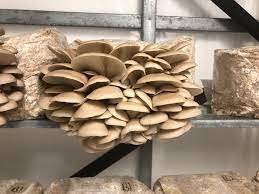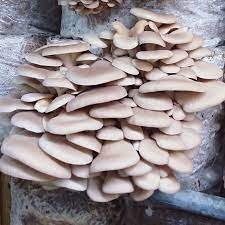Princess of Pearl Oyster Pleurotus Ostreatus
Princess of Pearl Oyster Pleurotus Ostreatus, commonly known as oyster mushroom, is one of the world’s most widely grown mushrooms. Not only does this fungus provide essential amino acids and minerals to humans, but it’s also one of the world’s most prolific pollinators.
It is widely used as a food ingredient and can be useful for myco-remediation, bioethanol production and degradation of agro-industrial waste. It makes an ideal substitute for meat and can be enjoyed in various dishes.
Characteristics
Oyster mushrooms are a group of gilled mushroom species that feed off decomposing wood, possessing saprotrophic characteristics and the ability to paralyze and consume nematodes, tiny worms.
These mushrooms can thrive on a variety of substrates, such as pasteurized straw, wood chips, sawdust, various grains, coffee grounds and agricultural waste. Due to their adaptability they can easily be grown both outdoors and indoors in beds.
They can be grown on a range of nutrient-rich materials, such as fresh fruit and vegetables, fish, dairy products and legumes. They tolerate a range of temperatures well and don’t seem particularly fussy about the pH level of their substrate.
Some oyster varieties thrive better in warmer temperatures than others, so you may want to select one that is better suited to your climate. For instance, pink oyster mushrooms are best suited to tropical locations while king oysters can withstand colder temperatures better.
Pearl oyster coloration can vary according to temperature, light and substrate. White varieties tend to grow better under less intense lights while darker types prefer brighter conditions.
Princess of Pearl Oyster Pleurotus ostreatus is an eye-catching variety featuring delicate ruffled flesh. This popular oyster mushroom variety is prized for its delectable and tender taste.
Mushrooms can be found around the world and often served as a side dish, in stews or sauteed. Not only do they contain fiber but also several essential vitamins and minerals, they make an ideal addition to any diet.
They contain b-glucans, which have been demonstrated to have beneficial effects on glucose and lipid metabolism. Furthermore, dietary sources of b-glucans can be an essential dietary component in treating cardiometabolic disorders like hypertension, diabetes and obesity.
Consuming this mushroom has been proven to have a beneficial effect on hunger and satiety levels, helping reduce binge eating risks. This is likely due to dopamine being released by the gastrointestinal tract which helps control food intake while suppressing hunger pangs. Furthermore, b-glucans found in this mushroom increase serotonin production within the body – known for its positive affect on moods.
Cultivation
Pleurotus species can be grown indoors in a greenhouse or other enclosed space, depending on the substrate and available light. Colors range from white to gray or brown depending on conditions. Some varieties possess bioluminescent properties and have become popularly known as “ghost mushrooms” due to their glow-in-the-dark effect.
Cultivating oyster mushrooms can be both simple and cost-effective. A reliable variety can yield a large number of mushrooms in an enclosed space, especially if grown without sunlight.
Substrates: Pasteurized straw, wood chips, sawdust, various grains and coffee grounds can be the ideal substrates for growing pearl oyster mushrooms. For better results, these can be supplemented with bran or seed derivatives for increased yields.
Once the mushrooms begin to form, mist the substrate with water twice daily to keep it hydrated and promote growth. Doing this will encourage mushrooms and prevent them from drying out during development.
 Spawning: Place sterilized substrate bags in your greenhouse and fill them with mushroom spawn (similar to sowing seeds for food crops). I usually use 20-30 grams of spawn per 1 kg bag, giving me an ample yield.
Spawning: Place sterilized substrate bags in your greenhouse and fill them with mushroom spawn (similar to sowing seeds for food crops). I usually use 20-30 grams of spawn per 1 kg bag, giving me an ample yield.
After a few days, you should begin to observe tiny mushroom pins forming out of the holes in the substrate (known as spores). Over the following 5-7 days, these will grow larger and flatten out at their edges; once this occurs, it’s time for harvesting.
Once they are ready to be harvested, cut them just before they stop growing or dry out completely. As these insects will continue to spread spores as they die, it is essential that you harvest them quickly.
Selecting the ideal oyster mushroom strain is key to successful cultivation of this variety. There are numerous strains available, and it’s essential that you select one suitable for your location and climate.
The oyster mushroom is an incredibly healthy and tasty food that can be grown at home or in a commercial setting. Packed full of nutrients, its delicate flavor fits in well with any cuisine. Not only that, but it’s also high in dietary fiber and protein as well as many essential fats and amino acids for extra nutritional support for your body.
Harvesting
Growing oyster mushrooms is a breeze, whether indoors or outdoors – and you don’t have to worry about them getting contaminated. They thrive on various substrates like pasteurized straw, wood chips, sawdust and various grains.
They’re an ideal option for recyclers looking to transform waste into edible mushrooms. You can use them for stock oyster mushroom production or by recycling wood and paper into edible mushrooms.
Princess of Pearl Oyster Pleurotus ostreatus is a common temperate oyster mushroom, capable of growing on various substrates. Depending on the temperature and light conditions, this species may produce white, gray, brown or black mushrooms.
The fruiting process occurs quickly and begins as a small knot of mycelium that grows into tiny “pins” that resemble fruit bodies. Each pin expands and forms part of larger clusters that ultimately split into smaller clusters and each form an individual pin.
Once the cluster reaches its full size, it is ready for harvesting. Oyster mushrooms are delicate so should be harvested from their base; cut with a knife and gently squeeze out any stem with your fingers.
Oyster mushrooms have a short shelf life, so it is best to pick them while still fresh and enjoy them immediately. You can store them in the fridge for several days or place them in a paper bag to extend their shelf life.
Oyster mushrooms are classified as saprotrophs, meaning they feed on decomposed organic material. Naturally gluten-free and nutrient dense, oyster mushrooms make an excellent alternative to grains-based foods. Oyster mushrooms also provide bioactive compounds like b-glucans which have been demonstrated to improve glucose and lipid metabolism, blood pressure, body weight and more. Plus they’re packed full of antioxidants which may protect the heart.
Preparation
Princess of Pearl Oyster Pleurotus ostreatus is one of the world’s most beloved edible mushrooms. It grows rapidly with high biological efficiency on various substrates and can easily be grown indoors or in greenhouses.
Oyster mushrooms differ in that they begin their lives as spores. Each fungus consists of billions of these tiny particles, and when they land in an ideal environment they sprout into individual strands known as hyphae. Over time these hyphae converge to form a mycelium which can eventually produce fruit.
Mycelium can take nutrients from its environment and use them for growth – this process is known as mycoremediation. If the mycelium grows too large, it may begin consuming other fungi and bacteria that compete for the same nutrients.
A healthy mycelium will possess an immune system, helping it defend against competing organisms. Furthermore, the mycelium can eliminate bacteria harmful to the mushroom.
To guarantee your mycelium’s health, you must eliminate any undesirable microbes from its substrate before it begins to grow. You can do this by either thoroughly rinsing with water or heat pasteurizing it; this will destroy all harmful organisms and also help destroy any cereal grains found in the straw.
Straw is the ideal substrate for growing pearl oyster mushrooms due to its accessibility and high biological efficiency. Before cultivation begins, straw should be moistened with either hydrated lime or heat treatment to promote rapid growth.
Once the substrate is prepared, you should place it in grow bags or buckets to increase humidity and ensure a successful yield for oyster mushrooms.
For optimal mushroom crop fruiting, ensure the grow bags are kept well ventilated. Ideally, aim for an 85% humidity level or higher; if this cannot be achieved, use a humidifier to increase humidity levels.

